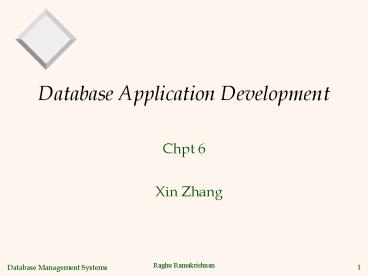Database Application Development - PowerPoint PPT Presentation
1 / 10
Title:
Database Application Development
Description:
Cursors. Can declare a cursor on a relation or query statement (which generates a ... which orders answer tuples, is only allowed in the context of a cursor. ... – PowerPoint PPT presentation
Number of Views:26
Avg rating:3.0/5.0
Title: Database Application Development
1
Database Application Development
- Chpt 6
Xin Zhang
2
Embedded SQL
- SQL commands can be called from within a host
language (e.g., C or Java) program. - SQL statements can refer to host variables
(including special variables used to return
status). - Must include a statement to connect to the right
database. - SQL relations are set-oriented.
- SQL supports a mechanism called cursor to handle
this.
3
Cursors
- Can declare a cursor on a relation or query
statement (which generates a relation). - Can open a cursor, and repeatedly fetch a tuple
then move the cursor, until all tuples have been
retrieved. - Can use a special clause, called ORDER BY, in
queries that are accessed through a cursor, to
control the order in which tuples are returned. - Fields in ORDER BY clause must also appear in
SELECT clause. - The ORDER BY clause, which orders answer tuples,
is only allowed in the context of a cursor. - Can also modify/delete tuple pointed to by a
cursor.
4
Cursor Declaration
Find names, and ages of those sailors whos
rating is above 7, in alphabetical order
EXEC SQL DECLARE sinfo CURSOR FOR SELECT
S.sname FROM Sailors S WHERE rating gt7 ORDER
BY S.sname
5
Embedding SQL in C An Example
- char SQLSTATE6
- EXEC SQL BEGIN DECLARE SECTION
- char c_sname20 short c_minrating float c_age
- EXEC SQL END DECLARE SECTION
- c_minrating random()
- EXEC SQL DECLARE sinfo CURSOR FOR
- SELECT S.sname, S.age FROM Sailors S
- WHERE S.rating gt c_minrating
- ORDER BY S.sname
- do
- EXEC SQL FETCH sinfo INTO c_sname, c_age
- printf(s is d years old\n, c_sname, c_age)
- while (SQLSTATE ! 02000)
- EXEC SQL CLOSE sinfo
6
Database APIs Alternative to embedding
- DBMS-independent
- ODBC JDBC
- Database can be across a network
7
JDBC steps
- Create the database in your dbms
- Register the database as a data source
- Import java.sql. at the beginning of your java
file. - Connect to a JDBC source
- Connection con DriverManager.getConnection(jdbc
oraclethin_at_coit-ora011521class,user,passw
d) - Create an SQL statement
- Statement stmt con.createStatement()
- stmt.executeUpdate("INSERT INTO sailor
VALUES(22,'dustin',7,45.0)")
8
JDBC steps cont.
- Execute the statement
- ResultSet rs stmt.executeQuery(Select from
) - Parse the result
- rs.next(), rs.getFloat
- ResultSetMetaData contains the information about
column - Close the statement and connection
- stmt.close()
- con.close
9
Useful resources
- JDBC tutorial http//java.sun.com/docs/books/tutor
ial/jdbc/index.html - UNCC COIT
- http//coit-servlet01.uncc.edu8080/support/?
- Example http//webpages/xinzhang/Teaching/SampleJ
DBC.java
10
SQL API in Java (JDBC)
- Connection con // connect
- DriverManager.getConnection(url, login",
pass") - Statement stmt con.createStatement() // set up
stmt - String query "SELECT name, rating FROM
Sailors" - ResultSet rs stmt.executeQuery(query)
- try // handle exceptions
- // loop through result tuples
- while (rs.next())
- String s rs.getString(name")
- Int n rs.getFloat(rating")
- System.out.println(s " " n)
- catch(SQLException ex)
- System.out.println(ex.getMessage ()
- ex.getSQLState () ex.getErrorCode
())































